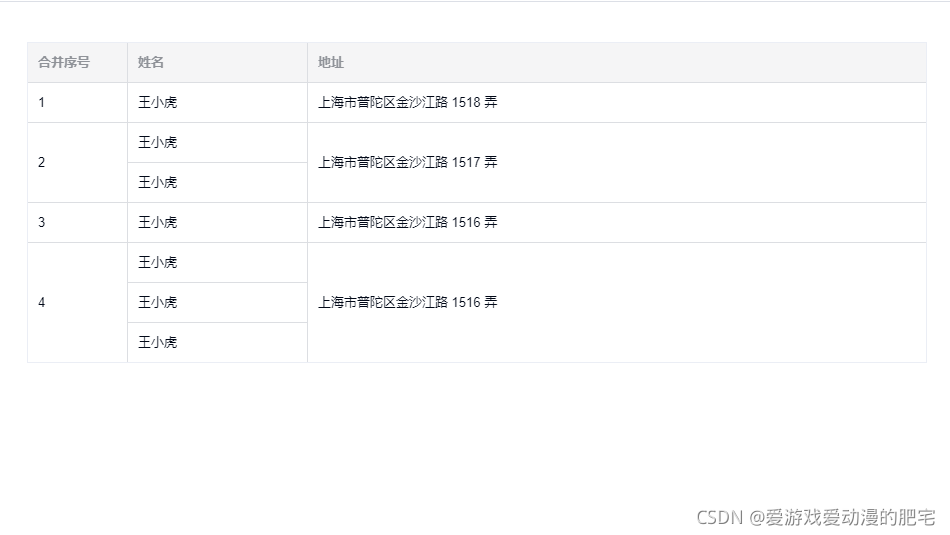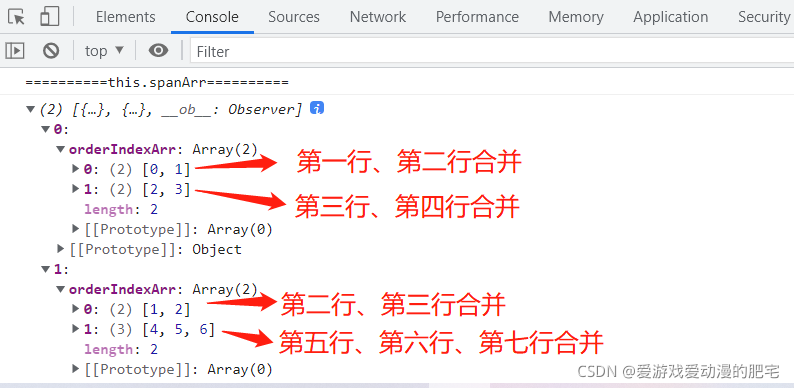el-table 行合并
爱游戏爱动漫的肥宅 人气:0页面实现行合并的情况还是比较常见的,但实现起来却有一点点难。官网的例子有,不过人家的合并逻辑是从第一行开始两行两行合并,不能根据数据动态合并,感觉参考意义不太大。实际需求一般都是根据表数据动态来进行合并的,也会有更复杂的情况,比如循环表格的。
以下的例子中,表格数据是放在页面的假数据,hbxh 值相同时,表示需要合并
示例一:单个表格
单个表格的比较简单,知道合并方法的使用基本就好弄了
<template>
<div>
<el-form
ref="testForm"
:model="testForm"
style="height: 600px;"
>
<el-row
style="padding: 10px"
>
<el-table
:data="testForm.tableData"
:span-method="colSpanMethod"
border
style="width: 100%;"
>
<el-table-column prop="hbxh" label="合并序号" width="100" />
<el-table-column prop="name" label="姓名" width="180" />
<el-table-column prop="address" label="地址" />
</el-table>
</el-row>
</el-form>
</div>
</template>
<script>
export default {
data() {
return {
spanArr: [], // 用于存放每一行记录的合并数
testForm: {
tableData: [
{
hbxh: '1',
name: '王小虎',
address: '上海市普陀区金沙江路 1518 弄'
}, {
hbxh: '2',
name: '王小虎',
address: '上海市普陀区金沙江路 1517 弄'
}, {
hbxh: '2',
name: '王小虎',
address: '上海市普陀区金沙江路 1519 弄'
}, {
hbxh: '3',
name: '王小虎',
address: '上海市普陀区金沙江路 1516 弄'
}, {
hbxh: '4',
name: '王小虎',
address: '上海市普陀区金沙江路 1516 弄'
}, {
hbxh: '4',
name: '王小虎',
address: '上海市普陀区金沙江路 1516 弄'
}, {
hbxh: '4',
name: '王小虎',
address: '上海市普陀区金沙江路 1516 弄'
}
] // 测试数据
},
}
},
created() {
this.getSpanArr(this.testForm.tableData)
},
methods: {
getSpanArr(data) {
// data就是我们从后台拿到的数据
for (var i = 0; i < data.length; i++) {
if (i === 0) {
this.spanArr.push(1);
this.pos = 0;
} else {
// 判断当前对象的指定属性值与上一个对象的指定属性值是否相等
if (data[i].hbxh === data[i - 1].hbxh) {
this.spanArr[this.pos] += 1;
this.spanArr.push(0);
} else {
this.spanArr.push(1);
this.pos = i;
}
}
}
},
colSpanMethod({ row, column, rowIndex, columnIndex }) {
if (columnIndex === 0 || columnIndex === 2) {
const _row = this.spanArr[rowIndex];
const _col = _row > 0 ? 1 : 0;
console.log(`rowspan:${_row} colspan:${_col}`);
return {
// [0,0] 表示这一行不显示, [2,1]表示行的合并数
rowspan: _row,
colspan: _col
};
}
}
}
}
</script>
效果:

示例二:循环表格
循环表格时,需要在表的每行数据传入一个值,代表是第几个表格,方便合并方法使用
<template>
<div>
<el-form
ref="testForm"
:model="testForm"
style="height: 600px;"
>
<el-row
v-for="(item, index) in testForm.tableList"
:key="index"
style="padding: 10px"
>
<el-table
:data="item"
:span-method="colSpanMethod"
border
style="width: 100%; margin-bottom: 20px;"
>
<el-table-column prop="hbxh" label="合并序号" width="100" />
<el-table-column prop="name" label="姓名" width="180" />
<el-table-column prop="address" label="地址" />
</el-table>
</el-row>
</el-form>
</div>
</template>
<script>
export default {
data() {
return {
spanArr: [], // 用于存放每一行记录的合并数
testForm: {
tableList: [
[
{
hbxh: '1',
name: '王小虎',
address: '上海市普陀区金沙江路 1518 弄',
tbIndex: 0
}, {
hbxh: '1',
name: '王小虎',
address: '上海市普陀区金沙江路 1517 弄',
tbIndex: 0
}, {
hbxh: '2',
name: '王小虎',
address: '上海市普陀区金沙江路 1519 弄',
tbIndex: 0
}, {
hbxh: '2',
name: '王小虎',
address: '上海市普陀区金沙江路 1516 弄',
tbIndex: 0
}
],
[
{
hbxh: '1',
name: '王小虎',
address: '上海市普陀区金沙江路 1518 弄',
tbIndex: 1
}, {
hbxh: '2',
name: '王小虎',
address: '上海市普陀区金沙江路 1517 弄',
tbIndex: 1
}, {
hbxh: '2',
name: '王小虎',
address: '上海市普陀区金沙江路 1519 弄',
tbIndex: 1
}, {
hbxh: '3',
name: '王小虎',
address: '上海市普陀区金沙江路 1516 弄',
tbIndex: 1
}, {
hbxh: '4',
name: '王小虎',
address: '上海市普陀区金沙江路 1516 弄',
tbIndex: 1
}, {
hbxh: '4',
name: '王小虎',
address: '上海市普陀区金沙江路 1516 弄',
tbIndex: 1
}, {
hbxh: '4',
name: '王小虎',
address: '上海市普陀区金沙江路 1516 弄',
tbIndex: 1
}
]
] // 测试数据
},
}
},
created() {
this.getSpanArr(this.testForm.tableList)
},
methods: {
getSpanArr(data) {
// 用一个对象数组来存放每个表中每一行记录的合并数
for (let m = 0, n = data.length; m < n; m++) {
this.spanArr.push({
tbArr: []
});
}
for (let i = 0, l = data.length; i < l; i++) {
let contactDot = 0; // 记录开始合并的行索引
data[i].forEach((item, index) => {
item.index = index
if (index === 0) {
this.spanArr[i].tbArr.push(1);
} else {
// 判断当前对象的指定属性值与上一个对象的指定属性值是否相等
if (item.hbxh === data[i][index - 1].hbxh) {
this.spanArr[i].tbArr[contactDot] += 1;
this.spanArr[i].tbArr.push(0);
} else {
this.spanArr[i].tbArr.push(1);
contactDot = index;
}
}
})
}
console.log('==========this.spanArr==========')
console.log(this.spanArr)
/* [
[2, 0, 2, 0],
[1, 2, 0, 1, 3, 0, 0]
] */
},
colSpanMethod({ row, column, rowIndex, columnIndex }) {
if (columnIndex === 2) {
const _row = this.spanArr[row.tbIndex].tbArr[rowIndex];
const _col = _row > 0 ? 1 : 0;
return {
// [0,0] 表示这一行不显示, [2,1]表示行的合并数
rowspan: _row,
colspan: _col
};
}
}
}
}
</script>
有循环的需求时,数据结构会比较复杂,需要耐心理清数据之间的关系
效果:

合并的关键主要就是要准确计算出每行记录的合并数,计算逻辑可能每个人会想得不太一样,以上的栗子仅代表一种实现方式,不同方式的朋友可以留言讨论
>>>>>>>>>今天又发现了一种新的逻辑>>>>>>>>>>>>>(2021-11-29)
<template>
<div>
<el-form
ref="testForm"
:model="testForm"
style="height: 600px;"
>
<el-row
v-for="(item, index) in testForm.tableList"
:key="index"
style="padding: 10px"
>
<el-table
:data="item"
:span-method="colSpanMethod2"
border
style="width: 100%; margin-bottom: 20px;"
>
<el-table-column prop="hbxh" label="合并序号" width="100" />
<el-table-column prop="name" label="姓名" width="180" />
<el-table-column prop="address" label="地址" />
</el-table>
</el-row>
</el-form>
</div>
</template>
<script>
export default {
data() {
return {
spanArr: [], // 用于存放每一行记录的合并数
testForm: {
tableList: [
[
{
hbxh: '1',
name: '王小虎',
address: '上海市普陀区金沙江路 1518 弄',
tbIndex: 0
}, {
hbxh: '1',
name: '王小虎',
address: '上海市普陀区金沙江路 1517 弄',
tbIndex: 0
}, {
hbxh: '2',
name: '王小虎',
address: '上海市普陀区金沙江路 1519 弄',
tbIndex: 0
}, {
hbxh: '2',
name: '王小虎',
address: '上海市普陀区金沙江路 1516 弄',
tbIndex: 0
}
],
[
{
hbxh: '1',
name: '王小虎',
address: '上海市普陀区金沙江路 1518 弄',
tbIndex: 1
}, {
hbxh: '2',
name: '王小虎',
address: '上海市普陀区金沙江路 1517 弄',
tbIndex: 1
}, {
hbxh: '2',
name: '王小虎',
address: '上海市普陀区金沙江路 1519 弄',
tbIndex: 1
}, {
hbxh: '3',
name: '王小虎',
address: '上海市普陀区金沙江路 1516 弄',
tbIndex: 1
}, {
hbxh: '4',
name: '王小虎',
address: '上海市普陀区金沙江路 1516 弄',
tbIndex: 1
}, {
hbxh: '4',
name: '王小虎',
address: '上海市普陀区金沙江路 1516 弄',
tbIndex: 1
}, {
hbxh: '4',
name: '王小虎',
address: '上海市普陀区金沙江路 1516 弄',
tbIndex: 1
}
]
] // 测试数据
},
}
},
created() {
this.getSpanArr2(this.testForm.tableList)
},
methods: {
getSpanArr2(data) {
for (let i = 0, l = data.length; i < l; i++) {
let orderObj = {}
data[i].forEach((item, index) => {
// item.index = index
if (orderObj[item.hbxh]) {
orderObj[item.hbxh].push(index)
} else {
orderObj[item.hbxh] = []
orderObj[item.hbxh].push(index)
}
this.spanArr[i] = {
orderIndexArr: []
}
// 将数组长度大于1的值 存储到this.orderIndexArr(也就是需要合并的项)
Object.keys(orderObj).forEach((key) => {
if (orderObj[key].length > 1) {
this.spanArr[i].orderIndexArr.push(orderObj[key])
}
})
})
}
console.log('==========this.spanArr==========')
console.log(this.spanArr)
},
colSpanMethod2({ row, column, rowIndex, columnIndex }) {
if (columnIndex === 2) {
for (let i = 0, l = this.spanArr[row.tbIndex].orderIndexArr.length; i < l; i++) {
let element = this.spanArr[row.tbIndex].orderIndexArr[i]
for (let j = 0; j < element.length; j++) {
let item = element[j]
if (rowIndex === item) {
if (j === 0) {
return {
rowspan: element.length,
colspan: 1
}
} else {
return {
rowspan: 0,
colspan: 0
}
}
}
}
}
}
}
}
}
</script>
效果:
同上
来看看前端打印的信息:

到此这篇关于el-table 行合并的实现示例的文章就介绍到这了,更多相关el-table 行合并内容请搜索以前的文章或继续浏览下面的相关文章希望大家以后多多支持!
加载全部内容